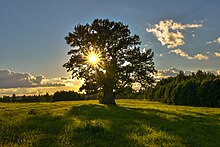Urvaste
| Urvaste | |||
|
|||
| State : |
|
||
| Circle : |
|
||
| Coordinates : | 57 ° 55 ' N , 26 ° 35' E | ||
| Area : | 139.3 km² | ||
| Residents : | 1,328 (2017) | ||
| Population density : | 10 inhabitants per km² | ||
| Time zone : | EET (UTC + 2) | ||
| Community type: | former rural community | ||
| Website : | |||

|
|||
Urvaste (German: Urbs ) is a former rural community in the Estonian district of Võru with an area of 139.9 km². It had 1,328 inhabitants (as of January 1, 2017). Urvaste has been part of the Antsla rural community since 2017 .
In addition to the main town Urvaste, the rural community includes the 13 villages Kassi, Kirikuküla, Koigu, Kuldre, Kõlbi, Lümatu, Pihleni, Ruhingu, Toku, Uhtjärve, Uue-Antsla, Vaabina and Visela.
The Urvaste Church, dedicated to Saint Urban , is the only medieval basilica- style church in Estonia. Its construction probably began at the end of the 13th century. It was first mentioned in a document in 1413.
In Urvaste, in addition to the Moravian Adam Koljo (approx. 1683-1759), the preacher Johann Christian Quandt worked from 1732 to 1750, under whose aegis the community developed into the first and most important center of the Moravian Brethren in Livonia .
The “Tamme Lauri Oak” in Urvaste, the oldest oak in Estonia, was depicted on the 10 kroner banknotes that were in circulation in Estonia until the introduction of the euro in 2011.
Web links
- Urvaste Municipality website (Estonian)
- Postage stamp with a picture of the Church of Urvaste



